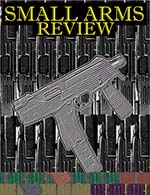Raffica: October 1998
By Dan Shea
“If you will not fight for the right when you can easily win without bloodshed; if you will not fight when your victory will be sure and not too costly; you may come to the moment when you will have to fight with all the odds against you and only a small chance of survival. There may even be a worse case. You may have to fight when there is no hope of victory, because it is better to perish than live as slaves.” - Sir Winston Churchill (attr.)
Astute Rafficarians may quickly catch up with me on one of the photos in this edition of Raffica. Here is why; for many years I have been asked the difference between a metric FAL magazine and an inch FAL magazine, and I thought I finally had the photos for you. Well, sort of. It just seemed like I never was in the right place at the right time to have both magazines in hand, and a camera as well.
At a recent visit to Reed Knight’s reference collection, I thought I would snap a shot of the two in between other projects. I grabbed a metric mag out of a gun, then looked and found an “Inch Pattern” gun and took it’s magazine, then did the photo comparison of the main difference- the front lugs. Upon returning the magazines to the rightful places, I discovered that the “Inch Pattern” FAL was in fact a “T-48”. Reed is always full of surprises, no exceptions this time.
The question from assorted readers has basically been- “How do I tell the difference between the two magazines?”
There are differences in each run of magazines that were made- from the originals, to the UK variants, the Canadians, and others. If you want the best information on FAL’s that is in print, Collector Grade Publications has the “Classic Edition” which contains all three of their books. I don’t want to get into all of the variations, but between the metric and the inch, the easiest way to tell is on the front of the top of the magazine, where the lug is.
On the metric magazines, this is a small dimple in the sheet metal of the magazine body. The dimple is raised to the outside of the magazine. On inch magazines, there is a lug welded to the front. The T-48 is very similar, if not identical, to the inch magazine lug, so I will let this picture suffice to illustrate it. Hope this gives you a quick clue to what the differences are.
Q2- I have one of the PIAT projectors that I want to set up for my WWII display. Are there dummy projectiles available for these?
A2- When the British PIATs (Projector, Infantry, Anti-Tank) were first brought into the US, there were some practice projectiles with them. I would characterize the PIAT as one great big firing pin and spring surrounded by a single tube of steel. The firing pin is about an inch in diameter! SAR will be covering these at length in the future, but I did manage to find a display version to photograph. It is at the US Infantry Museum at Fort Benning, Georgia. You should be able to get an idea of shape and scale from this photo.
Q3- I have an SR-25 rifle, and am always looking for magazines. I have been told that the original AR-10 magazines fit as well as the Knight Armament Company ones. While at a show recently, I looked at an SR-25 that had a different magazine entirely. Can I use any magazine that is called an SR-25?
A3- In Eugene Stoner’s original design, the magazine used was a slightly altered AR-10 waffle sided magazine. The alteration is one cut in the mag release slot, done with a mill, that extends the cut to fit the SR-25 release. (See photos). Once the surplus AR-10 magazines ran out, KAC started using the newly manufactured magazines that you have been seeing on other guns. Either magazine will fit your gun. If there is some question as to reliability of the magazine (If you are experiencing a feed problem) then check for the circled mark showing that KAC worked on the magazine. This is the quality control mark.
The modern Armalite Corporation, who manufacture the new AR-10 rifle series, utilizes a modified M14 magazine. These magazines do not interchange with the SR-25 series rifles. In the near future, SAR will be presenting ID guides to both the SR-25 and the AR-10 series guns.
Questions to: Dan Shea c/o SAR
This article first appeared in Small Arms Review V2N1 (October 1998) |
| SUBSCRIBER COMMENT AREA |
Comments have not been generated for this article.









